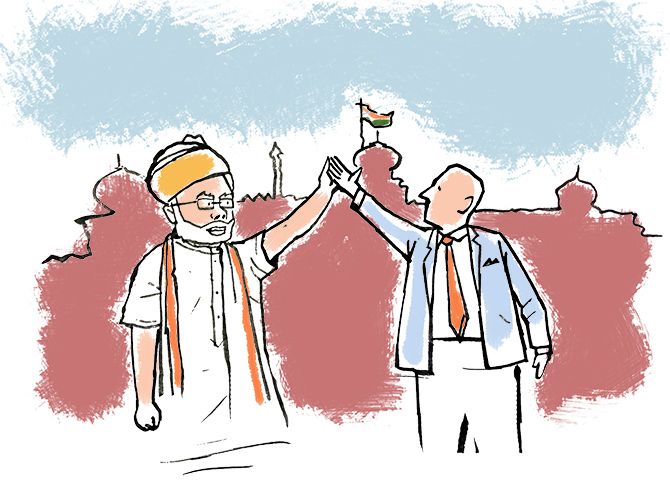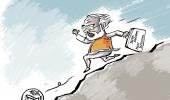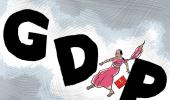'The private sector is now the engine for economic growth.
'Modi’s statement on Independence Day reflects an understanding of that truth.
'The issue for him is to create a dynamic for the corporate sector to grow and compete legitimately and establish healthy governance standards.
'Right now, that doesn’t seem to be in evidence,' says Kanika Datta.
Illustration: Dominic Xavier/Rediff.com

India’s wealth creators should not be eyed with suspicion, the prime minister stated from the ramparts of the Red Fort last month, because it is only when wealth is created that wealth will be distributed.
In normal circumstances, this would have been an unexceptionable statement.
In today’s context, the timing is a little unpropitious.
By wealth creators we assume Narendra Modi was referring to Indian entrepreneurs -- at any rate, this is how his finance minister defined the term five days later.
Is it really possible not to view these “wealth creators” with suspicion?
For one, corporate fraud and variations thereof -- from Nirav Modi to IL&FS to the Avantha group -- have dominated the headlines on an almost monthly basis these past two years, leaving the intelligentsia wondering what to expect next.
If we take in the past 15 years, starting with Ramalinga Raju’s confessions, the cause for suspicion is redoubled.
For another, if not the prime minister, his regime’s enforcement agencies have become manifestly uber-suspicious of the wealth creation of the wealth creators.
You know this has reached serious proportions when one of Modi’s staunchest corporate cheerleader, Mohandas Pai, complains publicly of “tax terrorism”.
Pai was speaking soon after Café Coffee Day’s V G Siddhartha was found dead and a letter allegedly written by him complained of harassment by the tax authorities (which may or may not be true).
The immediate context apart, the prime minister’s statement reflected a remarkable point of departure.
In the past, no prime minister would have dared fete the cause of the rich so openly.
This discretion had historic roots.
One was the very visible wealth creation by a slew of business groups -- from the Walchands to the Tatas and Birlas -- from the opportunities afforded by the two World Wars.
Although it is true that these business people mostly bankrolled the freedom struggle, too, it was clear that their wealth creation did not lead to meaningful wealth distribution in a dirt-poor country.
Like many leading intellectuals of his generation around the world, India’s first prime minister, Jawaharlal Nehru, was heavily influenced by the Soviet economic model (more so after he was given the standard curated tour of Stalin’s “reforms”).
Having experienced at first hand the abject poverty of United Provinces’ peasantry, he was convinced of the need for a State-led economy.
Thanks to P C Mahalanobis and the Planning Commission, the Indian economic template bore no resemblance to the State-driven capitalism of the Chinese model that emerged two decades later and helped China overtake India.
The Mahalanobis model involved intricate levels of controls that kept businessmen tangled in red tape and, inevitably, had a limited impact on economic activity or wealth distribution.
India’s famous Hindu rate of growth kept India poor.
Indira Gandhi spotted the political opportunity in India’s poverty, making a virtue out of protectionism, nationalism and the strengthening of the licence-permit raj.
Garibi Hatao was a great electoral slogan that masked the fact that the principal wealth creation was taking place at the level of the corrupt politician and the bureaucrat.
Rarely has poverty been more cynically exploited.
The suspicion against “wealth creators” has its genesis in this economic model.
It encouraged -- some might say forced -- business groups to deploy political relationships as a competitive advantage and block foreign and domestic competition (the automobile industry was particularly notorious for this).
This business-politician complex created a vicious circle.
With structural constraints causing business growth to crawl, taxing became an extractive enterprise.
Inevitably, the higher the tax, the higher the evasion; those fortunate to have export licences could sequester large chunks of wealth created in foreign tax havens.
No less inevitably, a politician emerged who viewed these wealth creators with suspicion: V P Singh as finance minister in Rajiv Gandhi’s government, whose “blacklist” spooked the business community like never before.
True, economic reform forced India Inc to raise efficiency and productivity and enabled it to expand, creating some degree of redistribution.
Lower tariff barriers and delicensing permitted some degree of economic expansion and people to become relatively more prosperous.
For the first time, wealth creation was a legitimate, even laudable, ambition, but the political class still hesitated to own this message.
Pro-poor remained the UPA’s shtick, even as millions came out from under poverty.
Today, the problem is that the principal old economy wealth creators of India Inc still suffer from the licence raj hangover.
Four decades of punitive taxation and limited competition worked themselves into the DNA of corporate India’s governance standards.
So much so that tax evasion, family-oriented corporate structures, a complete disregard of boards and an ability to suborn the state-owned banking system are as rife today as they were pre-1991.
The private sector is now the engine for economic growth.
Modi’s statement on Independence Day reflects an understanding of that truth.
The issue for him is to create a dynamic for the corporate sector to grow and compete legitimately and establish healthy governance standards.
Right now, that doesn’t seem to be in evidence.












 © 2025
© 2025